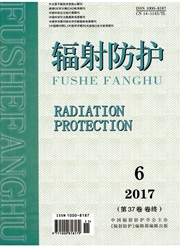

 中文摘要:
中文摘要:
^90Sr和^137Cs是核电站环境监测中受关注的两种重要核素。本文采用一种食物链转移剂量估算模式和中国参考人及浙江(省)人食品消费量等参数,结合秦山核电基地外围环境放射性水平监测数据,计算了秦山核电基地外围^90Sr和^137Cs的公众食入摄入量及内照射剂量。结果表明,^90Sr、^137Cs摄入量的主要食物来源为米及其制品、蔬菜以及水产品,^90Sr所致公众年平均待积有效剂量为2.5μSv,明显高于^137Cs的剂量贡献(0.36μSv)。本文仅以秦山核电基地作为例子,介绍评价方法。实际上,秦山核电基地外围环境介质中^90Sr和^137Cs的含量水平与运行前的本底调查结果比较没有改变。
 英文摘要:
英文摘要:
^90Sr and ^137Cs are important radionuclides in environmental investigation related to nuclear power stations. A mode of intake estimation and dose assessment via various food chains is made in this paper. Based on daily food consumption and dietary composition for Chinese reference man and for man of Zhejiang province and the concentration of ^137Cs and ^90Sr around QNPP Base, the intake estimation and dose of ^90Sr and ^137Cs around QNPP Base are calculated. It shows that the main food sources of intake of ^90Sr and ^137Cs are rice, vegetable and aquatic product. Also the public average annual committed effective dose of ^90Sr (2.5 p.Sv) is obviously higher than the contribution of dose of the ^137Cs (0.36 μSv). A practical estimation method was made by taking QNPP Base as an example in this paper,while no background change occurs after its commercial operation.
 同期刊论文项目
同期刊论文项目
 同项目期刊论文
同项目期刊论文
 期刊信息
期刊信息
